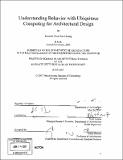Understanding behavior with ubiquitous computing for architectural design
Author(s)
Cheung, Kenneth Chun-Wai
DownloadFull printable version (10.36Mb)
Other Contributors
Massachusetts Institute of Technology. Dept. of Architecture.
Advisor
Kent Larson.
Terms of use
Metadata
Show full item recordAbstract
Understanding the relationship between workplace environment and behavior is an important concern for designers. We report on a pilot study where ubiquitous computing was used to examine workplace activity quality in a commercially designed workplace environment. Data were collected from twelve adult participants in the same professional workplace, for twenty-one workdays during one month. The data collection system was composed of small wireless infrared motion sensors, a Bluetooth-based positioning system using mobile phones, and a context-sensitive self-report survey administered on the mobile phones. Participants were automatically queried about their work practices and their environment via these mobile phones, every time they changed their locations in the workplace. Questions were also asked during the remainder of the day, albeit less frequently. We describe how software visualization tools were developed to visualize the data collected during the experiment, and we report on some of the attributes of subjects' behaviors that can be observed using the tools. Implications of these results with respect to research methods and enabled design methods are discussed.
Description
Thesis (S.M.)--Massachusetts Institute of Technology, Dept. of Architecture, 2007. Includes bibliographical references (p. 77-81).
Date issued
2007Department
Massachusetts Institute of Technology. Department of ArchitecturePublisher
Massachusetts Institute of Technology
Keywords
Architecture.